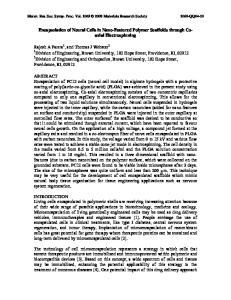Diversity of Electrospinning Approach for Vascular Implants: Multilayered Tubular Scaffolds
- PDF / 1,626,802 Bytes
- 15 Pages / 595.276 x 790.866 pts Page_size
- 45 Downloads / 335 Views
REVIEW
Diversity of Electrospinning Approach for Vascular Implants: Multilayered Tubular Scaffolds Emad Tolba 1 Received: 14 October 2019 / Revised: 11 March 2020 / Accepted: 24 March 2020 # The Regenerative Engineering Society 2020
Abstract The biomimetics of biological structures found in nature remains one of the most promising approaches to engineer functional tissues from natural or synthetic biocompatible materials for the replacement of damaged or injured parts of the human body. Recently, medical therapeutic regimes have advanced into a new era, overcoming the known mechanical and biological variances that occur when using autologous or synthetic grafts. Basically, the core concept of tissue biofabrication, commonly referred to as tissue engineering, is to find out the favorable cellular microenvironments to grow a living tissue prior to clinical uses. In fact, the ability of stem cells to regenerate is controlled via signaling pathways (growth factors) and supporting materials (scaffolds) that guide the cellular activities. After the first successful experiments to fabricate polymer fibers from their solutions, Cooley proposed the use of an electric field a century ago (Cooley (US 692:631,1902 ). The electrospinning technique has been continually developed as a fruitful polymer processing technique to draw ultrafine nonwoven fibers. Electrospun polymer fibers have been used for a wide range of technical and biotechnical applications such as filtration, organic solar cells, tissue engineering, and drug releasing implants. In this regard, this review begins with an overview about the various spinning approaches for the fabrication of polymer fibers as well as the basic principles of electrospinning process. In addition, this review will highlight vascular bypass surgery and, in particular, the needs for vascular tissue engineering. Finally, the review includes some of the latest attempts to improve the mechanical and biological properties of electrospun polymeric fibers and summarizes the challenges and prospects for the future. Lay Summary However, vascular defects are treated successfully via bypass surgical bypass grafting using autologous or synthetic vessels. The small-diameter vessels (less than 6) are often associated with high failure rate. This review reports some of the recent features that should be highlighted to fabricate an ideal graft for small-diameter vascular grafts. The review introduces multilayered conduits as an alternative approach to overcome the known mechanical and biological mismatches of single layered vascular grafts of electrospun polymers. Keywords Polymer fibers . Electrospinning . Vascular grafts . Tissue engineering and blood vessel fabrication
Introduction A deep insight into the treatment approaches for restoring lost or malfunctioning body parts can be seen as a mirror of the scientific advances of mankind. By the end of last century, the fabrication of living tissues has attracted the attention of the * Emad Tolba [email protected] 1
Polymers and Pigments Department
Data Loading...











